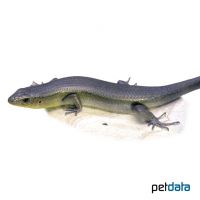Bronze Mabuya (Eutropis macularia)
| Bronze Mabuya Eutropis macularia | |
|---|---|
| Name | Bronze Mabuya |
| Name Lat. | Eutropis macularia |
| Synonym | Mabuya macularia |
| Family | Skinks |
| Family lat. | Scincidae |
| Order | Scaled Reptiles |
| Order lat. | Squamata |
| Origin | South and Southeast Asia |
| Habitat | Forests |
| Diet | Insects, fruits |
| Humidity | 60-80 % |
| Behavior | Peaceful |
| Keeping | Pair, harem |
| Care Level | Moderate |
| Reproduction | Oviparous |
| Housing | Humid terrarium |
| Life Span | 7-8 years |
| Protection | No |
| Metric Units | |
| Size | 15 cm |
| Temperature | 25-28 °C |
| Temperature Local | 40 °C |
| Housing Size | 60 x 40 x 40 cm |
| US Units | |
| Size | 5.9" |
| Temperature | 77-82 °F |
| Temperature Local | 104 °F |
| Housing Size | 25" x 15" x 15" |
Distribution and habitat
Sun skinks are widespread in South and Southeast Asia, from Pakistan to India and Sri Lanka to Vietnam. They live in dry rocky and bushy landscapes as well as in open forests mostly near water bodies.
Maintenance
Minimum dimensions for the terrarium, according to the size and number of animals
| 1-2 animals | 6KRL x 4KRL x 3KRL (L x W x H) |
Head-torso length (KRL) is measured on the largest animal. For each additional animal, increase the footprint by 15%. A terrarium of e.g. 60 x 40 x 40 cm is recommended, which should be placed in a quiet and vibration-free place. 
You need a humid terrarium with flat climbing branches, stone structures (hiding places, visual protection) and structured back and side walls (e.g. cork covering) as well as a large water bowl for bathing and a 10-15 cm deep substrate for digging. Terrarium humus or a soil-peat mixture, covered with some foliage and bark mulch, as well as planting for decoration (ficus, ivy, etc.) is suitable. The substrate should always be kept slightly moist. Once a day the inside of the terrarium should be finely sprayed with water. A rain or mist system is ideal
| Temp. day: 25-28 °C | Temp. night: 20-22 °C | Temp. local: up to 40 °C | Humidity: 60-80 |
Thermostatically controlled floor heating is recommended. Lighting duration must be 12-14 hrs, depending on the season. They need sunny places with radiant heat and daily UV irradiation.
Diet
The diet consists of live insects, such as crickets, house crickets, small grasshoppers, cockroaches, spiders, etc., occasionally supplemented with sweet fruits (e.g. bananas, berries). After habituation, ready-made food for insectivorous reptiles is often accepted. Wax moths should rarely be fed in very small amounts because of their large fat content. Regular addition of minerals and vitamins (e.g. by dusting the food) is important. Young animals should be offered food daily, adults 4-5 times a week. Drinking water must always be available
A regular and varied diet promotes health and prevents deficiency symptoms.
Reproduction and breeding
The sexes are difficult to distinguish. Males have a slightly broader head and a thicker tail root. A reliable sex determination is only possible by testosterone determination or endoscopy.
They are oviparous and a clutch consists of 2-6 eggs. The incubation period is 35-40 days at a temperature of 27-30 °C. The young can be raised in a group. Small insects such as fruit flies, aphids, micro echinoderms etc. are suitable as initial food
The life expectancy can be 7-8 years.
Important
Adult males behave territorially during the mating season
Depending on the area of origin, their temperature and humidity requirements vary and must be taken into account.
They need moist hiding places and sunny places according to their need for warmth, such as climbing branches or stones irradiated by a spot
With fruit and honey water as food for the feeders, their quality can be upgraded.
The terrarium must have good ventilation without drafts and meet the species specific needs. Measuring devices such as thermometers, hygrometers, etc. are necessary. The lighting has to correspond to the species-specific day-night rhythm and has to be placed in such a way that the animals cannot injure themselves. The terrarium should be locked in such a way that neither unauthorized persons can open it nor the animals can escape. Contamination must be removed regularly
Further literature can be found in your pet store.
References
Text: petdata; Image: petdata
Source: BMELV (1997): Tierschutzgutachten - Mindestanforderungen an die Haltung von Reptilien; ENGELMANN (2006): Zootierhaltung - Tiere in menschlicher Obhut: Reptilien und Amphibien, Harri Deutsch Verlag
- Gemäß § 21 Abs. 5 Tierschutzgesetz idgF
